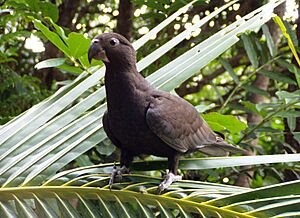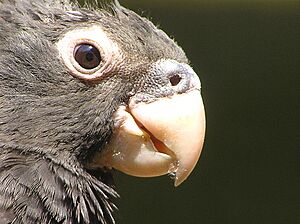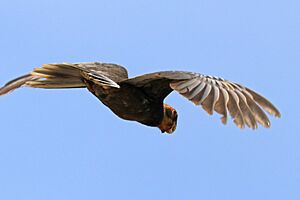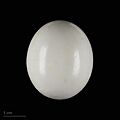Greater vasa parrot facts for kids
Quick facts for kids Greater vasa parrot |
|
|---|---|
 |
|
| In Madagascar | |
 |
|
| C. v. drouardi, female in breeding plumage | |
| Conservation status | |
| Scientific classification | |
| Genus: |
Coracopsis
|
| Species: |
vasa
|
The greater vasa parrot (Coracopsis vasa) is a special type of parrot. It's one of two kinds of vasa parrots. The other is the lesser vasa parrot. You can find these parrots living in Madagascar and the Comoros islands.
Contents
What's in a Name? (Taxonomy)
Every animal has a scientific name. This helps scientists around the world know exactly which animal they are talking about. The greater vasa parrot was first described in 1812 by a scientist named George Shaw.
There are three slightly different types, or subspecies, of the greater vasa parrot:
- Coracopsis vasa
- Coracopsis vasa comorensis
- Coracopsis vasa drouhardi
- Coracopsis vasa vasa
Some scientists also place this bird in a different group called Mascarinus.
Life Cycle and Habits
The greater vasa parrot has a very interesting way of living and raising its young. Their breeding season is usually between October and December.
Female greater vasa parrots are about 25% bigger than the males. They are also physically stronger and more dominant. These parrots live in groups where each female might have several male partners.
During the time when females are sitting on their eggs and raising chicks, something amazing happens. Their head feathers fall out, and their skin turns a bright orange color! They also sing complicated songs from spots near their nest. These songs help attract males. The males then bring food back to the female, which she eats while she is off the nest. Females also protect their nesting area from other females during this time.
Their Home and Food
You can often find greater vasa parrots in the dry forests of Madagascar. This is different from the lesser vasa parrot, which prefers humid forests.
These parrots eat wild berries, fruits, nuts, and seeds. They also enjoy eating crops like maize, millet, and rice from farms. They often fly and feed in large, noisy groups.
Greater vasa parrots are active even on moonlit nights. If it's not a bright night, they gather in large, noisy groups to sleep in the tops of tall trees. One parrot usually acts as a lookout to warn the others if there's danger.
Scientists have observed greater vasa parrots at Lincolnshire Wildlife Park doing something very unique. They use tools to grind things! These parrots were seen holding date stones and small pebbles in their beaks. They used these tools to grind calcium-rich dust from seashells. This behavior happens most often just before the breeding season. Males were seen doing it more than females. Scientists think the females need extra calcium to make strong eggshells. The males might then feed this calcium-rich dust to the females.
How They're Doing
The greater vasa parrot is common in some areas. Overall, their numbers are slowly going down. However, their population is not decreasing fast enough to be considered in danger of extinction.
The International Union for Conservation of Nature (IUCN) keeps track of how well different species are doing. They have classified the greater vasa parrot as a species of "least concern." This means they are not currently at high risk.
Images for kids





